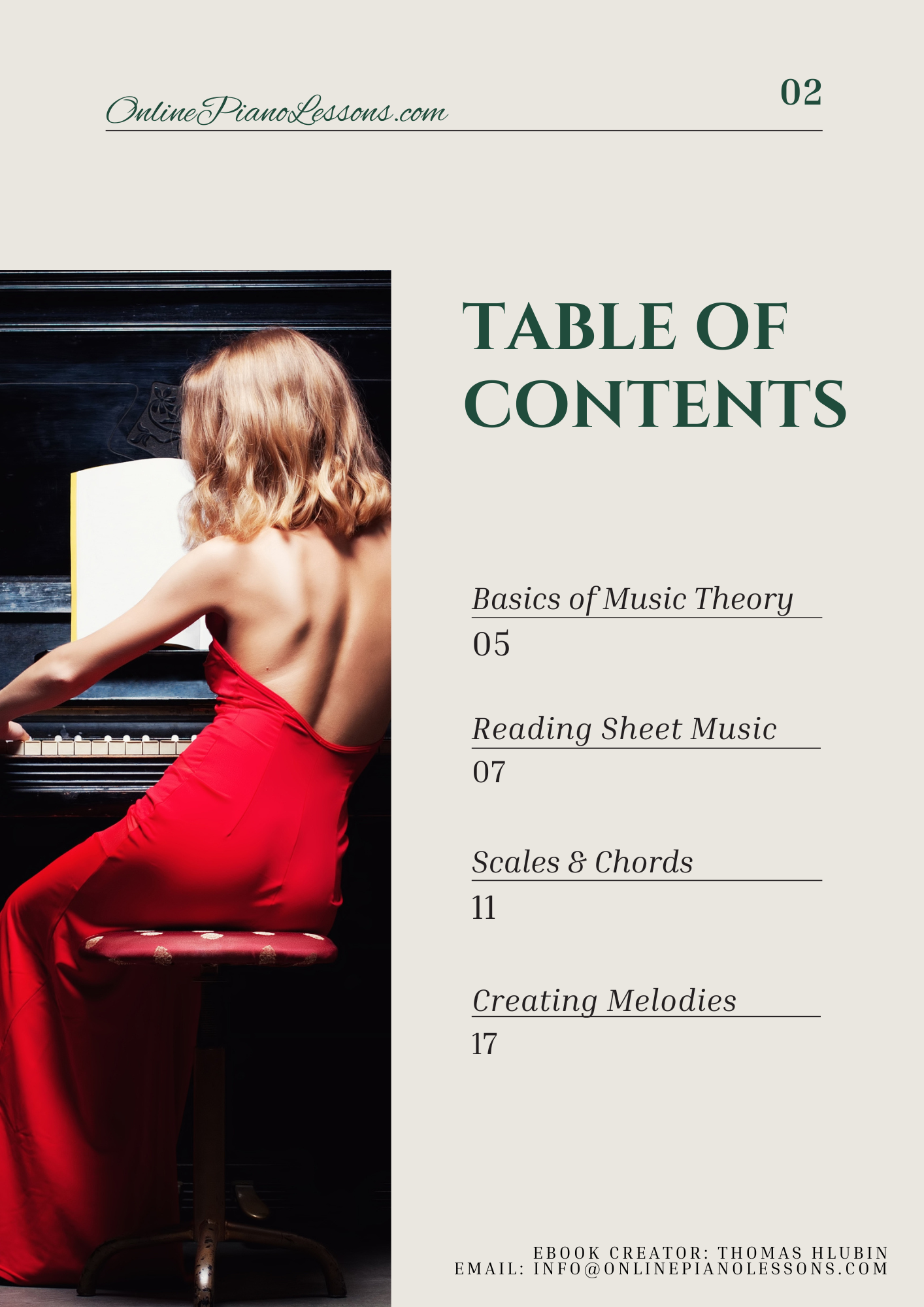Learning all piano scales is one of the most powerful ways to improve your technique, ear training, and musical creativity. Scales form the foundation of everything you play — from classical pieces to jazz improvisation and pop melodies. Understanding them unlocks your full potential as a pianist, helping you see how notes relate to one another across the keyboard.
In this definitive guide, we’ll explore all piano scales, including major and minor scales, modes like Ionian and Dorian, and more unique patterns such as pentatonic and blues scales. You’ll learn what each one sounds like, how they’re built, and why mastering them matters.
What Are Piano Scales?
At their core, piano scales are simply a sequence of notes arranged in ascending or descending order. Each scale follows a specific pattern of intervals — whole steps and half steps — which gives it a unique sound and emotional character.
Scales are the DNA of music. They shape the melodies you sing, the harmonies you hear, and the chords you play. By learning all piano scales, you’ll be able to understand music on a deeper level, improve your improvisation, and gain better control over your hands and fingers.
The Importance of Learning All Piano Scales
If you’ve ever wondered why pianists spend so much time practicing scales, here’s why they matter:
- Builds Technique – Scales strengthen your fingers, develop dexterity, and improve hand coordination.
- Improves Ear Training – You’ll begin to recognize tonal patterns and key centers instantly.
- Enhances Improvisation – Knowing all piano scales gives you freedom to create melodies on the spot.
- Improves Sight-Reading – Recognizing key signatures becomes much easier.
- Helps Composition – You’ll know how to choose notes that sound right together when writing music.
In short, scales make you a more complete, confident musician.
The 12 Major Piano Scales
The major scales are the most fundamental patterns in Western music. They sound bright, happy, and resolved. Every major scale follows the same interval formula:
Whole – Whole – Half – Whole – Whole – Whole – Half
Here are all 12 major piano scales:
- C Major: C – D – E – F – G – A – B – C
- G Major: G – A – B – C – D – E – F♯ – G
- D Major: D – E – F♯ – G – A – B – C♯ – D
- A Major: A – B – C♯ – D – E – F♯ – G♯ – A
- E Major: E – F♯ – G♯ – A – B – C♯ – D♯ – E
- B Major: B – C♯ – D♯ – E – F♯ – G♯ – A♯ – B
- F♯ Major: F♯ – G♯ – A♯ – B – C♯ – D♯ – E♯ – F♯
- D♭ Major: D♭ – E♭ – F – G♭ – A♭ – B♭ – C – D♭
- A♭ Major: A♭ – B♭ – C – D♭ – E♭ – F – G – A♭
- E♭ Major: E♭ – F – G – A♭ – B♭ – C – D – E♭
- B♭ Major: B♭ – C – D – E♭ – F – G – A – B♭
- F Major: F – G – A – B♭ – C – D – E – F
Once you learn these, you’ll have the foundation for understanding nearly every other scale on the piano.
The 12 Natural Minor Piano Scales
The natural minor scales are the emotional counterpart to the major scales. They sound darker, sadder, or more introspective. The interval pattern is:
Whole – Half – Whole – Whole – Half – Whole – Whole
Here are all 12 natural minor piano scales:
- A Minor: A – B – C – D – E – F – G – A
- E Minor: E – F♯ – G – A – B – C – D – E
- B Minor: B – C♯ – D – E – F♯ – G – A – B
- F♯ Minor: F♯ – G♯ – A – B – C♯ – D – E – F♯
- C♯ Minor: C♯ – D♯ – E – F♯ – G♯ – A – B – C♯
- G♯ Minor: G♯ – A♯ – B – C♯ – D♯ – E – F♯ – G♯
- D♯ Minor: D♯ – E♯ – F♯ – G♯ – A♯ – B – C♯ – D♯
- D Minor: D – E – F – G – A – B♭ – C – D
- G Minor: G – A – B♭ – C – D – E♭ – F – G
- C Minor: C – D – E♭ – F – G – A♭ – B♭ – C
- F Minor: F – G – A♭ – B♭ – C – D♭ – E♭ – F
- B♭ Minor: B♭ – C – D♭ – E♭ – F – G♭ – A♭ – B♭
You can also explore harmonic minor and melodic minor variations — both add unique flavor to minor harmony and are widely used in classical and jazz piano.
Ionian to Locrian
Long before major and minor scales became standard, Western music used the modes — ancient tonal systems that each carry a distinct mood.
Each mode uses the same notes as a major scale but starts from a different scale degree. For example, the C major scale (C–D–E–F–G–A–B–C) contains all modes depending on where you begin:
- Ionian – same as the major scale (C–D–E–F–G–A–B–C)
- Dorian – D–E–F–G–A–B–C–D (minor feel with raised 6th)
- Phrygian – E–F–G–A–B–C–D–E (Spanish flavor)
- Lydian – F–G–A–B–C–D–E–F (dreamy, raised 4th)
- Mixolydian – G–A–B–C–D–E–F–G (major with flat 7th)
- Aeolian – A–B–C–D–E–F–G–A (natural minor)
- Locrian – B–C–D–E–F–G–A–B (dark, unstable)
These piano modes are used extensively in jazz, film music, and contemporary pop because they create different moods than typical major or minor scales.
Pentatonic Scales on the Piano
The pentatonic scale contains just five notes, making it one of the simplest and most versatile patterns. It’s found in nearly every culture’s music — from Asian folk songs to blues and rock.
There are two main types of pentatonic scales:
- Major Pentatonic Scale: 1 – 2 – 3 – 5 – 6 (C–D–E–G–A–C)
- Minor Pentatonic Scale: 1 – ♭3 – 4 – 5 – ♭7 (A–C–D–E–G–A)
Because it avoids semitones, the pentatonic scale always sounds pleasing, making it perfect for improvisation on the piano. Many beginner melodies and famous guitar solos use this pattern.
Blues Scales on the Piano
The blues scale evolved directly from the minor pentatonic, but adds one extra “blue note” — a flattened fifth that gives it its soulful, expressive quality.
- Formula: 1 – ♭3 – 4 – ♭5 – 5 – ♭7 – 1
- Example in C: C – E♭ – F – F♯ – G – B♭ – C
This scale is central to jazz, rock, and gospel. Once you’ve learned it, try improvising over a 12-bar blues progression on the piano — you’ll immediately hear its emotional power.
Chromatic and Whole Tone Scales
Not all piano scales are built around tonal centers like major and minor. Some are designed for color and motion rather than tonality.
- Chromatic Scale: Every note in the octave, moving by half steps (C–C♯–D–D♯–E–F–F♯–G–G♯–A–A♯–B–C). It’s perfect for glissandos or transitions between keys.
- Whole Tone Scale: Built entirely from whole steps (C–D–E–F♯–G♯–A♯–C). It produces a dreamy, floating sound often used by Debussy and other impressionist composers.
These scales show how piano music can move beyond traditional harmony into more atmospheric textures.
Exotic and Cultural Scales
Many other piano scales come from non-Western traditions, offering unique tones and intervals. A few examples include:
- Arabic Scale (Hijaz): 1 – ♭2 – 3 – 4 – 5 – ♭6 – 7 – 1
- Hungarian Minor Scale: 1 – 2 – ♭3 – ♯4 – 5 – ♭6 – 7 – 1
- Japanese Scale (In Sen): 1 – ♭2 – 4 – 5 – ♭7 – 1
Exploring these helps you develop a global ear and adds cultural depth to your piano playing.
How to Practice All Piano Scales
To truly master all piano scales, consistency is key. Follow these tips for effective practice:
- Start Slowly – Focus on accuracy before speed.
- Use Both Hands – Practice hands separately, then together.
- Vary Rhythms and Articulations – Play staccato, legato, or in triplets.
- Explore Different Octaves – Expand your comfort zone across the keyboard.
- Apply Scales to Music – Use them in improvisation, compositions, or pieces.
When you integrate all piano scales into your daily routine, you’ll see dramatic improvements in control, speed, and musical understanding.
Conclusion
Learning all piano scales isn’t just an exercise — it’s a journey toward true musical fluency. From the bright clarity of major scales to the rich mystery of exotic ones, every scale adds a new layer to your expressive toolkit.
The more you study and practice these patterns, the more natural music-making becomes. Whether you’re composing, improvising, or performing, mastering all piano scales will make you a more confident, creative pianist.
FAQ
How many piano scales are there in total?
There are 12 major and 12 minor scales, plus dozens of modes, pentatonic, blues, and world scales — so potentially over 60 if you count every variation.
What scale should beginners learn first?
Start with C major and A minor. They contain only white keys, making them perfect for beginners.
Why do I need to learn all piano scales?
Knowing all scales improves finger control, musical understanding, and improvisation skills.
How long does it take to master them?
It depends on your practice habits, but consistent daily work can cover all major and minor scales in a few months.
Are scales really used in real music?
Absolutely — every melody, solo, and chord progression is built on scales. The more you know, the more fluent your playing becomes.







 Hi, I'm Thomas, Pianist Composer,
Hi, I'm Thomas, Pianist Composer,  I love playing piano, creating new melodies and songs, and further developing my online piano course and making updates/additions to my site OnlinePianoLessons.com!
I love playing piano, creating new melodies and songs, and further developing my online piano course and making updates/additions to my site OnlinePianoLessons.com!  Now that is what I call fun!
Now that is what I call fun!
